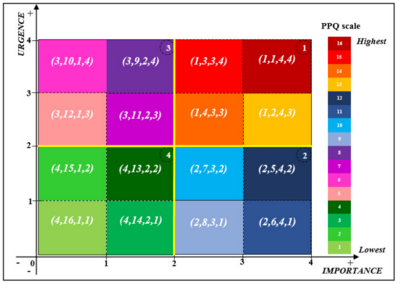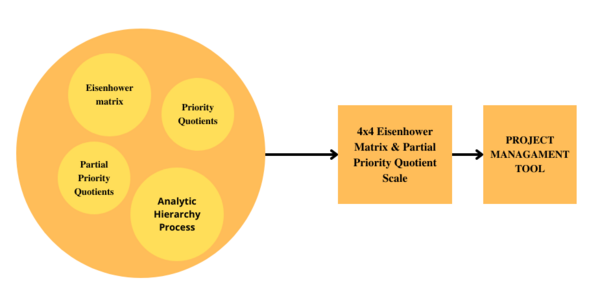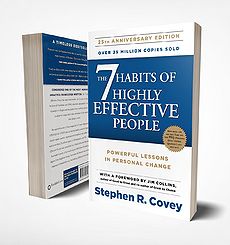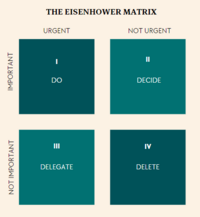The Eisenhower urgent/important matrix
(→Quadrant 1) |
(→Framework) |
||
| Line 34: | Line 34: | ||
= '''Framework''' = | = '''Framework''' = | ||
| − | [[File:Urgentimportantmatrix2.png| | + | [[File:Urgentimportantmatrix2.png|300px|thumb|right|'''Figure 2''': The urgent/important matrix]] |
The Eisenhower matrix is a graphical diagram used in strategy and planning. Stephen R. Covey claims that people spend time in one of four ways. <ref name="7h"/> Hence, the diagram contains four quadrants: important/urgent, important/non-urgent, nonimportant/urgent, and non-important/non-urgent. <ref name="TSD"/> In order to further explore 4 quadrants of the time management matrix, definitions of ''urgent'' and ''important'' should be studied. | The Eisenhower matrix is a graphical diagram used in strategy and planning. Stephen R. Covey claims that people spend time in one of four ways. <ref name="7h"/> Hence, the diagram contains four quadrants: important/urgent, important/non-urgent, nonimportant/urgent, and non-important/non-urgent. <ref name="TSD"/> In order to further explore 4 quadrants of the time management matrix, definitions of ''urgent'' and ''important'' should be studied. | ||
| Line 47: | Line 47: | ||
== Quadrant 1 == | == Quadrant 1 == | ||
| − | [[File:Q1.PNG|200px|thumb| | + | [[File:Q1.PNG|200px|thumb|center|'''Figure 2''': Quadrant1 (own figure, based on <ref name="AU"/> ]] |
'''Quadrant I''' is both urgent and important. It deals with significant results that require immediate attention. The activities in Quadrant I are most often referred to as ''“crises”'' or ''“problems”'' with a given deadline. Tasks with clear deadlines and consequences for not taking immediate action fit into that Quadrant. <ref name="AU"/> Quadrant I consumes many people involved in management field, such as crisis managers, problem-minded people, deadline-driven producers. | '''Quadrant I''' is both urgent and important. It deals with significant results that require immediate attention. The activities in Quadrant I are most often referred to as ''“crises”'' or ''“problems”'' with a given deadline. Tasks with clear deadlines and consequences for not taking immediate action fit into that Quadrant. <ref name="AU"/> Quadrant I consumes many people involved in management field, such as crisis managers, problem-minded people, deadline-driven producers. | ||
Revision as of 15:25, 16 February 2023
Prioritization of actions and obligations is an inseperable part of effective project management. Defining a prioritization framework supports building an impactful project roadmap.[1] Moreover, prioritizing projects' requirements is needed to provide a clarified direction in order to maximize the value of the project deliverable. [2] The Eisenhower matrix, also known under the name of Eisenhower Decision Matrix, Eisenhower Box, or Urgent-Important Matrix is one of task and actions' prioritization methods designed to enhance productivity and time-management efficiency. The tool’s concept was developed by a former president of the United States Dwight Eisenhower. Eisenhower based the idea on categorizing certain items by taking into account their urgency and importance. [3] [4]
This article looks further into the Eisenhower Matrix as a Project, Program and Portfolio management method from the perspective of people and their self-management performance. Following chapters discuss historical background of the matrix, next moving to the characterization of the template itself split into 4 specific quadrants. Subsequently, application of the tool both in daily life and in project management cases is presented, followed by examples. Limitations of the matrix are critically discussed, and finally, the article also examines possible effects of merging the Eisenhower Matrix with other used prioritization methods, resulting in enhanced deliverables. [5] [6] Lastly, drawbacks and limitations of the Eisenhower box are examined, considering the fact of the method’s simplicity.
Contents |
Brief Historical background
Dwight Eisenhower
A person behind a concept of the urgent/important matrix is Dwight David “Ike” Eisenhower. He was an American military officer and statesman who served as the 34th president of the United States from 1953 to 1961. As a president of the United States he led the construction of the Interstate Highway System, created NASA, signed into law the first major piece of civil rights legislation since the end of the Civil War, obtained truce in Korea, welcomed Alaska and Hawaii into the union, and many more accomplishments. His thorough understanding of the difference between the urgent and important enabled him to succeed. In a 1954 speech, Eisenhower quoted Dr J. Roscoe Miller, president of Northwestern University, who said:
“I have two kinds of problems, the urgent and the important. The urgent are not important, and the important are never urgent.”
- Dwight D. Eisenhower, speech to the Second Assembly of the World Council of Churches[7]
The quoted “Eisenhower principle” is thought to be the way he managed to organize his priorities and workload.
The 7 Habits of Highly Effective People
Stephen R. Covey popularized Eisenhower’s framework of urgent vs. important in 1989 in his book The 7 Habits of Highly Effective People. He was a multitalented personality who was recognized for his work as a successful businessman, educator and an influential public speaker. [8] Covey's inspirational book is considered to be the psychology handbook of the '90s, the first most influential business book of the twentieth century and one of the top-ten most influential management books ever. Covey believed that the essence of the best thinking in the area of time management can be captured in a single phrase: Organize and execute around priorities. [9] As a result of Covey’s work, the Eisenhower Matrix has become a widely used time-management and decision-making framework in business. [9]
“Effective management is putting first things first. While leadership decides what “first things” are, it is management that puts them first, day-by-day, moment-by-moment. Management is discipline, carrying it out.”
- Stephen R. Covey, 1989, 7 Habits of Highly Effective People: Powerful Lessons in Personal Change[9]
Framework
The Eisenhower matrix is a graphical diagram used in strategy and planning. Stephen R. Covey claims that people spend time in one of four ways. [9] Hence, the diagram contains four quadrants: important/urgent, important/non-urgent, nonimportant/urgent, and non-important/non-urgent. [5] In order to further explore 4 quadrants of the time management matrix, definitions of urgent and important should be studied.
Urgent equals requiring prompt attention. Urgent matters insist on action, pressing on the practitioner. They are usually perfectly visible and cause reaction. [9] Often, task order is based on the urgency.
Important means “of great significance or value; likely to have a profound effect on success” [9]. How one defines importance, therefore, potentially affects success. Tasks can be important for various reasons: societal, individual, organizational, etc. Importance is about the impact of
accomplishing the task; bringing intrinsic benefit to someone or some group. [5]
Quadrant 1

Quadrant I is both urgent and important. It deals with significant results that require immediate attention. The activities in Quadrant I are most often referred to as “crises” or “problems” with a given deadline. Tasks with clear deadlines and consequences for not taking immediate action fit into that Quadrant. [7] Quadrant I consumes many people involved in management field, such as crisis managers, problem-minded people, deadline-driven producers.
Quadrant 2
Quadrant II consists of not urgent & important. Author Stephen Covey believes that Quadrant 2 is the sweet spot of time management. This is the spot where you are focused not on problems (as with Quadrant I) but on opportunities and growth. Living from this quadrant of the matrix means leaving proactive and prioritizing activities that help to grow skills and energy, and contribute to accomplishing meaningful goals. Quadrant 2 is where “deep work” happens because the tasks are largely freed of pressing distractions. [7]
Quadrant 3
Quadrant III is both not important & urgent. These are urgent items that pop up and demand instant attention. However, because they are far from being necessary, they do not inevitably require time, and they can, therefore, be assign to someone else. [4] The reality is that the urgency of these matters is often based on the priorities and expectations of others. [9] These tasks are often set by others and do not move you closer to long-term goals. Covey suggests delegating as many Q3 tasks as possible. [7]
Quadrant 4
Quadrant IV fits not urgent and not important tasks. They are considered to be time-wasting activities that should be ruthlessly cut out. These activities don’t contribute to progress on one's goals but can end up taking over large chunks of time. [7] Eventually, tasks in quadrant IV should be erased.
Application of the matrix
Daily life duties' prioritization
Implementation in Project, program and portfolio management
Merging with other prioritization methods
AHP method

Two decades after the Eisenhower’s matrix, between 1971 and 1975, Thomas L. Saaty developed the Analytic Hierarchy Process, AHP. AHP is a theory and methodology for relative measurement, used to derive ratio scales from both discrete and continuous paired comparisons. It can cover the most basic to the most complex problems presented as a hierarchy with the same structure. No matter what the studied issue is, it should be examined in comparison to other similar entities in such a way that the outcome is less influenced by personal judgement and as objective as possible. Therefore, the AHP focuses on defining priorities, based on the proportions between entities and not their exact measurements. The comparison must be evaluated with a scale of numbers that indicates how many times more important and dominant one element is over another with respect to the criteria or property to which they are compared. [6]
The common point of Eisenhower method and AHP method is that they are both classified as Multi-Criteria Decision Analysis (MCDA), also known as the Multi-Criteria Decision-Making (MCDM), concerned with structuring and solving decision and planning, as well as evaluating multiple conflicting criteria in decision-making. Nevertheless, the Eisenhower matrix is doubtlessly less objective comparing to the Analytic Hierarchy Process with its objective approach. Merging of these 2 methods is based on calculating Priority Quotients (PQs) of analyzed elements, that are next affected into corresponding quadrants of the matrix. [6]
A Priority Quotient (PQ) is calculated for each element by using the following formula:

Then, accordingly to the result of PQs, each element is assigned to the specific quadrant of the matrix in a descending sort. If the matrix does not fulfill the need of the practitioner, a more precise analysis should be conducted. A Partial Priority Quotient (PPQ) may be calculated regarding the needs of the practitioner, for instance using the urgency and importance factor and any other relevant criteria index. Furthermore, the Eisenhower matrix can be split into more precise sub¨matrixes divided into sub-quadrants that ease allocating the analyzed elements. [6]

The Sun Diagram

The Eisenhower Matrix may be extended to The Sung Diagram by adding fit. That is, if the agent (e.g., person, company, or group) is required for the task. By adding a third binary variable, the Sung diagram is a suitable representation. The Eisenhower Box reflects on two dimensions, importance and urgency, meanwhile the Venn diagram incorporates a Forgotten Third Dimension of Fitness. The missing element of the Eisenhower Matrix: the fitness for the practitioner to complete the task. The decision for fitness has two components:
- Capability: is the agent the most capable to accomplish this task? Certain tasks require training or practice. In fact, evidence shows that aligning tasks with strengths or capabilities increases productivity and satisfaction. Moreover, the agent must not have the ability to delegate to
someone else who is more trained or practiced.
- Ipseity: does completing this task contribute to one’s ipseity (sense of self)? Does it contribute to one's mission or goal? [5]
Once the decision whether or not the task is important, urgent, and fit have been made, the task is assigned one of the eight outcomes.
Drawbacks and limitations
References
- ↑ The-Product-Managers-Complete-Guide-to-Prioritization-by-ProductPlan, © ProductPlan 2023.
- ↑ THE STANDARD FOR PROJECT MANAGEMENT, 7th edition 2021.
- ↑ Master the Moment - Fifty CEOs Teach You the Secrets of Time Management, Pat Brans © 2010 British Informatics Society Limited
- ↑ 4.0 4.1 https://www.productplan.com/glossary/eisenhower-matrix/, 6th of February 2023
- ↑ 5.0 5.1 5.2 5.3 5.4 The Sung Diagram: Revitalizing the Eisenhower Matrix", Hannah Bratterud1, Mac Burgess2, Brittany Terese Fasy2(B) , David L. Millman2 , Troy Oster2, and Eunyoung (Christine) Sung2, 2021 LINK:https://www.researchgate.net/profile/Christine-Sung/publication/343686873_The_Sung_Diagram_Revitalizing_the_Eisenhower_Matrix/links/60066bc392851c13fe1f5aa2/The-Sung-Diagram-Revitalizing-the-Eisenhower-Matrix.pdf
- ↑ 6.0 6.1 6.2 6.3 6.4 6.5 Eisenhower matrix * Saaty AHP = Strong actions prioritization? Theoretical literature and lessons drawn from empirical evidences, Alfred Homère NGANDAM MFONDOUM1*, Mesmin TCHINDJANG2, Jean Valery MEFIRE MFONDOUM3, Isabelle MAKOUET4, 2019 LINK:https://www.iaetsdjaras.org/gallery/3-february-880.pdf
- ↑ 7.0 7.1 7.2 7.3 7.4 7.5 The Eisenhower Matrix Avoid the "Urgency Trap" with Dwight D. Eisenhower's famous prioritization framework, accessed 14 February 2023, https://todoist.com/pl/productivity-methods/eisenhower-matrix#the-eisenhower-matrix-—-urgent-vs-important
- ↑ Famous Authors, accessed 14 February 2023, https://www.famousauthors.org/stephen-r-covey
- ↑ 9.0 9.1 9.2 9.3 9.4 9.5 THE SEVEN HABITS OF HIGHLY EFFECTIVE PEOPLE, Stephen R. Covey, 1989 https://ati.dae.gov.in/ati12052021_1.pdf


